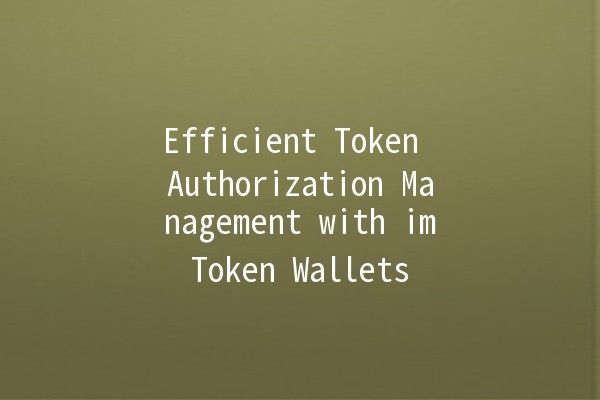In the rapidly evolving world of cryptocurrency, security and efficiency in managing your digital assets are of paramount importance. One of the pivotal aspects of this management is token authorization—a crucial element that ensures your tokens are accessed and used only by trusted applications. This article will explore effective strategies for managing token authorization using the imToken wallet, a popular choice among cryptocurrency enthusiasts. By the end, you'll possess valuable insights and practical techniques that will enhance your productivity and improve your security posture.
Token authorization refers to the process of granting specific permissions to applications to interact with your digital assets. In the context of the imToken wallet, this involves deciding which tokens can be accessed by thirdparty services and ensuring these permissions are carefully managed to protect against unauthorized access.

To maximize the benefits of your imToken wallet, consider implementing the following five practical techniques for managing token authorization efficiently:
Description: Regularly reviewing which tokens are authorized for thirdparty access is crucial. This can help identify outdated or unnecessary permissions that could pose a risk.
Application Example: Schedule a biweekly or monthly audit where you log into your imToken wallet and check the list of authorized applications. Remove any applications you no longer use or trust. This simple routine can significantly enhance your security posture.
Description: Be meticulous about which applications you authorize to access your tokens. Always do your due diligence before granting permissions.
Application Example: Before connecting your wallet to a new decentralized application (dApp), research its credibility through community forums or reviews. Only proceed with reputable platforms that have a track record of security and reliability.
Description: Some wallets allow you to grant access to specific tokens rather than all your holdings. This practice mitigates risk by limiting exposure.
Application Example: If you're using imToken, verify if the wallet allows tokenspecific permissions when authorizing a new dApp. For example, if a dApp requires access to a specific ERC20 token, grant access only to that token instead of your entire portfolio.
Description: Adding an extra layer of authentication helps prevent unauthorized access, even if someone obtains your wallet credentials.
Application Example: Set up multifactor authentication on your imToken wallet. Typically, this involves linking your wallet to an authentication app like Google Authenticator or SMS verification. This additional step significantly bolsters your security during token authorization.
Description: Understanding the inherent risks associated with smart contracts can help you avoid pitfalls in token authorization.
Application Example: Familiarize yourself with how smart contracts work and the potential vulnerabilities that can arise. Stay updated on news about recent exploits in the DeFi ecosystem, which may influence which applications you decide to use.
Beyond the aforementioned techniques, here are additional best practices to keep in mind:
The cryptocurrency landscape is everchanging. Engage in continuous learning through reputable sources, webinars, and community discussions to stay updated on token authorization practices.
Explore the various features offered by the imToken wallet. Familiarize yourself with the settings related to token management and authorization permissions available in the app.
Always ensure you have your wallet’s recovery phrase stored securely. This precaution will safeguard your assets in the event of unauthorized access or device loss.
Token authorization plays a critical role in managing which applications can access your digital assets. By carefully controlling these permissions, you enhance the security and privacy of your cryptocurrency holdings.
Research is key. Check community forums, read user reviews, and look for any past security incidents related to the dApp. Only authorize access for applications with a wellestablished reputation.
Yes, you can revoke access to authorized applications through your imToken wallet settings. Regularly auditing your permissions can help ensure that only trusted applications retain access.
If you authorize a malicious application, it may gain access to your funds, leading to potential loss. That’s why it’s crucial to only allow trusted applications and regularly check authorizations.
While not mandatory, multifactor authentication significantly enhances your wallet's security. It’s highly recommended to add this layer of protection.
Aim to review your authorizations every month or whenever you connect to a new dApp. Keeping your access list uptodate will help you maintain control over your assets.
By adopting these strategies for token authorization management within your imToken wallet, you can significantly mitigate risks and enhance your overall experience in the cryptocurrency space. Understanding the importance of security and staying vigilant through regular audits will empower you to protect your digital assets effectively. Remember, being proactive in managing your token authorizations is key to enjoying the full benefits of your cryptocurrency investments.
Incorporating these practices into your regular cryptocurrency management routine will not only enhance your security but also optimize your experience with the imToken wallet. Happy managing!